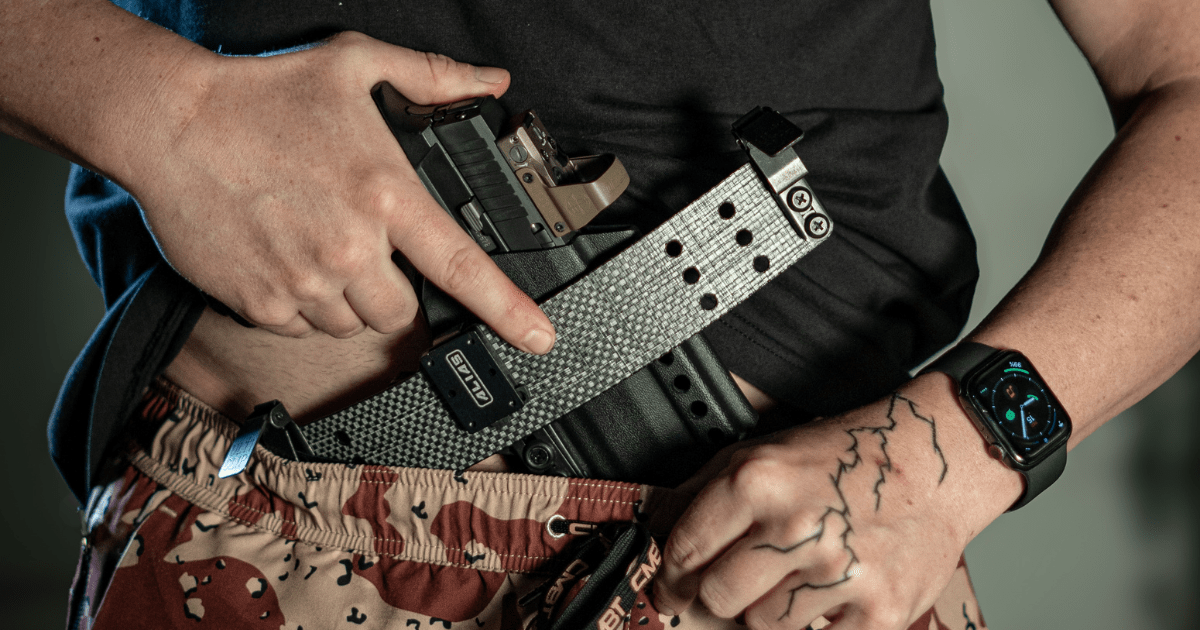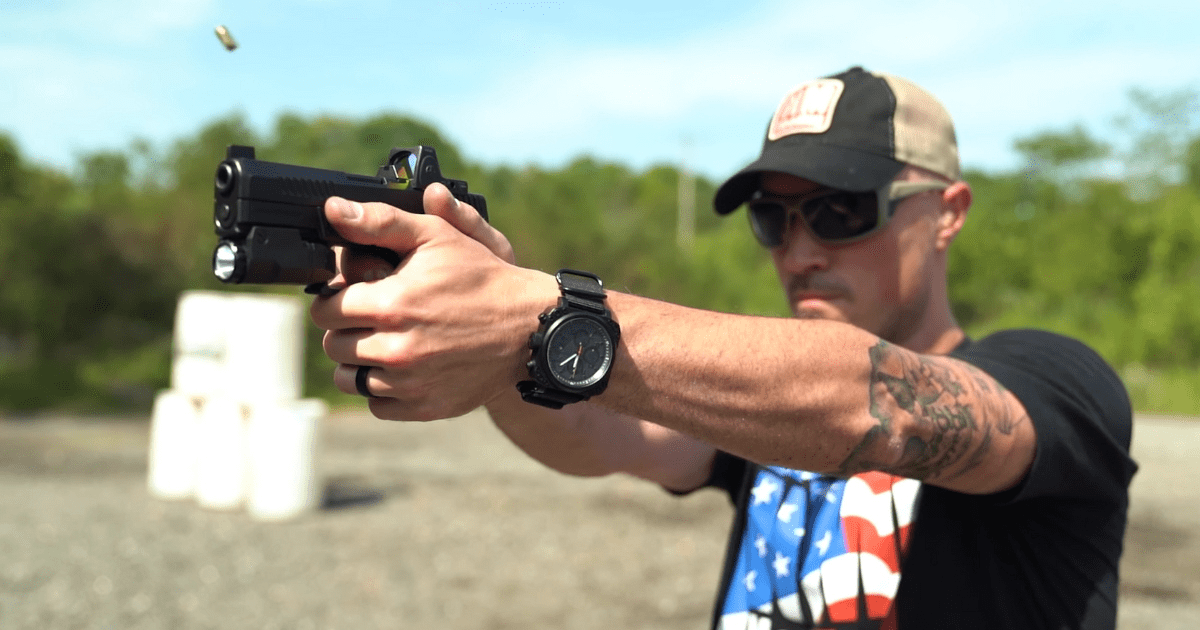Concealed carry with a tucked-in shirt presents unique challenges but can be overcome with proper technique and equipment. So whether you’re in an office setting, attending a formal event, or going about your everyday business, we’ll equip you with the knowledge and strategies for effective concealed carry.
Understanding the Basics of Concealed Carry with a Tucked-In Shirt
Many prefer concealed carry for its discretion and convenience. It allows you to go about your day without drawing unnecessary attention to your firearm.
How you dress can affect how effectively you conceal your weapon without sacrificing comfort or mobility. Your clothing must hide your firearm and allow easy access to it in an emergency. This is where the challenge of a tucked-in shirt comes in.
When dressed in a tucked-in shirt, concealing a firearm becomes a bit more complex. The shirt’s snug fit against your body, and the lack of loose fabric make it difficult to hide a holster and firearm. Furthermore, the tucked-in fabric can hinder drawing the weapon quickly and smoothly.
Additionally, the style and cut of your shirt and the type of pants you wear can also impact how effectively you can conceal your weapon. A shirt that is too tight may reveal the outline of your firearm (known as “printing”), while one that is too loose may look unkempt and draw unwanted attention.
Can you conceal carry with your shirt tucked in?
Yes! The key to successfully carrying concealed with a tucked-in shirt lies in finding the balance between concealment and accessibility by choosing the right holster, considering your clothing, and positioning it correctly.
What holster is best for wearing with a tucked-in shirt?

You’ll want an inside-the-waistband (IWB) holster that’s designed with clips or loops that attach to your belt, allowing you to tuck your shirt in around the gun and holster. This design feature makes the firearm nearly invisible while still allowing you to wear your shirt like you want.
An excellent example is the Alias Belt System from NeoMag. Our innovative system offers adjustable cant and ride height, allowing you to customize the position of your firearm for optimal comfort and concealment. With its slim design and high-quality build, the Alias Belt System provides a secure and discreet solution for concealed carry with a tucked-in shirt.
What is the difference between IWB holsters and tuckable holsters?
Not much.
The primary difference between an IWB holster and a “tuckable” holster is the clip used for the holster. An IWB holster can easily be a “tuckable” holster so long as it has a vertical holster clip with space to tuck your shirt in behind it.
So buying a special “tuckable” holster to conceal carry with your shirt tucked in isn’t necessary.
That’s one of the great benefits of the Alias System – you can carry your firearm on your battle belt at the gun range or conceal carry with your shirt tucked. It’s versatile to serve you in all the ways you carry while offering quick and easy access to your firearm.
And with the Alias, you don’t see a holster clip on the outside of your belt because the receiver is hidden inside, making it even more concealed when tucked in.
What do you wear when concealed carrying?
The clothes you wear affect how effectively you can conceal your firearm. Here are some tips to conceal carry with a shirt tucked in a bit easier:
- Wear a shirt with patterns: Patterns can help break up the outline of your firearm and reduce the chances of printing.
- Wear a shirt with a looser fit: A slightly loose shirt can provide enough fabric to adequately cover your firearm without looking untidy.
- Look at the shirt’s fabric and length: Shirts made of thicker fabrics can help conceal firearms. Check to make sure the shirt is long enough to stay tucked in during movement.
- Consider your pant size and style: A larger pant size can allow you to wear your holster and tuck in your shirt more comfortably, while a higher-waisted pant can allow you to bend over or sit without your gun causing discomfort.
- Consider adding layers: Even with a tucked-in shirt, a vest, jacket, or sweater can provide an additional layer of concealment, especially useful in cooler weather.
- Don’t forget clothing accessories: A sturdy belt designed for gun carry can support the firearm’s and holster’s weight, ensuring they stay in place throughout the day. Prefer not to wear a belt? Read The Advantages of Using a Beltless Holster for Concealed Carry.
Remember, the goal of concealed carry is to blend in while maintaining easy access to your firearm. Combining a quality holster and suitable clothing can help you achieve this balance.
What’s the best position for an IWB holster with a tucked-in shirt?
For carrying a concealed firearm with an IWB holster while wearing a shirt that is tucked in, finding the best holster position is important for both comfort and accessibility. Here are two recommended positions:
- Appendix carry: Located directly in front, around the 1 to 2 o’clock position (for right-handed users) or the 10 to 11 o’clock position (for left-handed users). This position allows for easy access to the firearm and tends to be more concealable under a tucked-in shirt. However, comfort can vary greatly depending on your body type and the size of the firearm.
- Strong side hip carry: Positioned just behind the hip bone on your dominant side (usually around the 3 o’clock position for right-handed individuals or the 9 o’clock position for left-handers). This is one of the most traditional and popular carry positions, but it does have a slower draw since you can’t use your weak-side hand to clear your shirt on your strong side.
When choosing the best holster position, consider the following factors:
- Comfort: Your holster should not cause discomfort during extended periods of wearing. This includes when you’re sitting, standing, or moving.
- Concealment: Your firearm should not print or outline on your clothing. Different body types and clothing styles might affect how well a firearm is concealed in various positions.
- Accessibility: You should be able to draw the firearm quickly and efficiently without obstruction.
- Safety: Ensure your firearm is securely held in the holster, and the trigger is completely covered and protected.
How do I carry a spare magazine when carrying concealed with a tucked shirt?
Carrying a spare magazine when carrying concealed is important for ensuring you have enough ammunition in a self-defense scenario.
Here are some common methods:
- Pocket carry: Some choose to carry their spare magazine in a pocket. For instance, the NeoMag is an innovative product that allows you to clip a spare magazine to your pocket’s edge, making it discreet yet easily accessible. Our magnetic pocket magazine holder utilizes a powerful magnet and clip to hold your magazine in place throughout the day.
- Magazine pouches/holsters: These are designed specifically for carrying spare magazines. They can be worn on the belt, inside the waistband (IWB), or even attached to an ankle rig.
- IWB clips: They can attach directly to the spare magazine, allowing you to clip them inside your waistband. This method keeps the magazine secure and concealed but may require practice to ensure a quick and efficient reload.
- Off-body carry: Carrying in a bag, purse, or other off-body method is another option, though it tends to be less preferred due to the increased risk of separation from the firearm.
Practicing your reload from wherever you carry your spare magazine is important to ensure you can do so efficiently and safely.
How do you draw from under a tucked-in shirt?

Drawing a firearm from under a tucked-in shirt requires practice to ensure it is safe and efficient. Here’s a step-by-step guide on how to draw from an inside-the-waistband (IWB) holster with a tucked-in shirt.
1. Clear the garment
- With your weak hand (non-dominant hand), reach across your body to grasp the bottom hem of your shirt. The goal is to pull the shirt up and away from the holster and firearm.
- Lift upward and outward to clear the shirt entirely from the firearm, holding it high enough to ensure it doesn’t obstruct your draw.
- This movement should be practiced to become a single, smooth action.
2. Grip the firearm
- With your strong hand (dominant hand), move to grip the firearm firmly.
- Ensure your fingers are properly positioned — your index finger should be along the side of the firearm frame or slide, not on the trigger.
- Establish a proper grip while the firearm is still in the holster. A good grip from the start makes the draw smoother and prepares you for a proper stance once the firearm is drawn.
3. Draw the firearm
- Draw the firearm straight up out of the holster. The motion should be direct and efficient to minimize the time it takes.
Practice, practice, practice
Becoming comfortable with your chosen method of concealed carry requires regular practice. This includes practicing drawing, reholstering, and even sitting and moving around with your holstered firearm.
Start slowly, focusing on each step’s accuracy and safety, then gradually increase your speed as you become more comfortable and proficient.
It’s also recommended to do several practice draws each time you get dressed. This helps ensure that your clothing doesn’t hinder your draw and that your firearm is properly concealed.
Clothing, Position, and Practice

Concealed carry is much more than simply choosing a firearm and a holster. It’s about integrating your self-defense strategy seamlessly into your daily life. Whether selecting the right clothing to tuck in your shirt, finding the most comfortable and practical holster position, or mastering the technique for a smooth, quick draw requires consideration and practice.
Remember to stay informed, stay prepared, and never underestimate the value of regular training and self-evaluation on your concealed carry journey.














Outstanding info and very informative. As always, thank you, @Neomag and Alias! Absolutely, top notch!
Can you use this same system for the right side hip carrier I dont appendix I like mine on the hip
Yes you can!
Can I use this system for hip carry on right side I do not appendix carry
Yes you can!